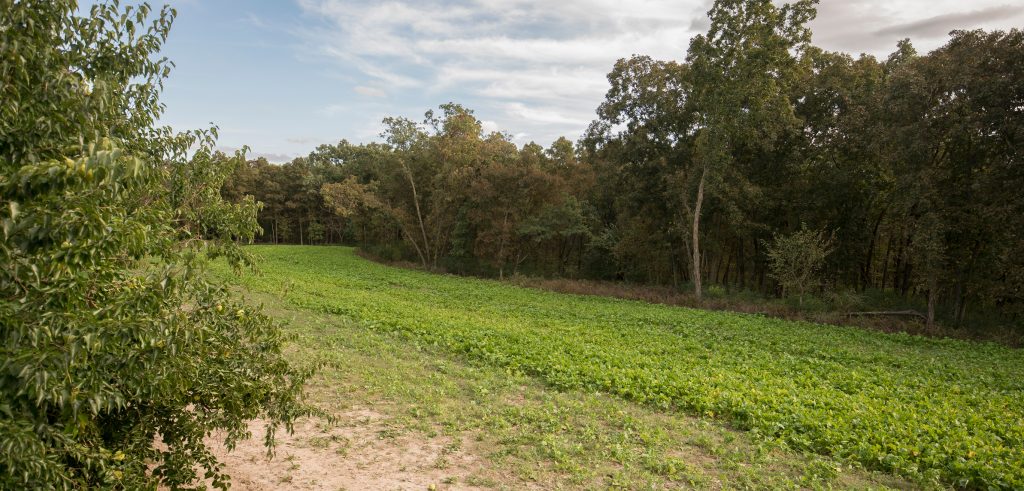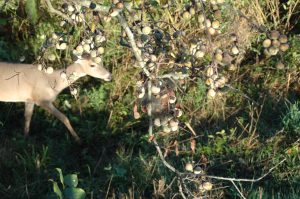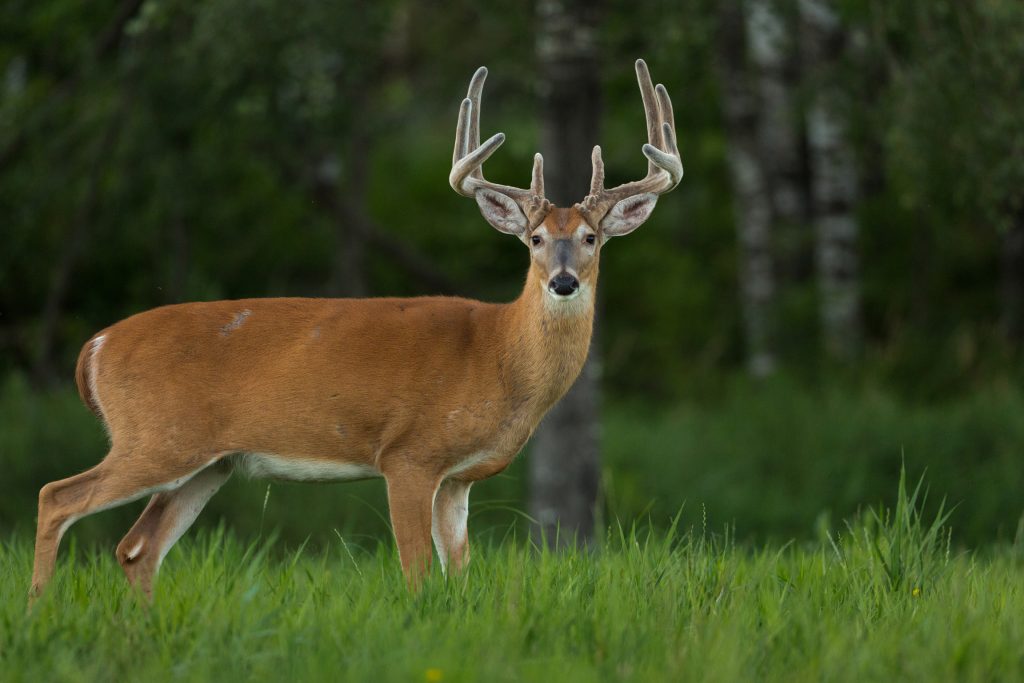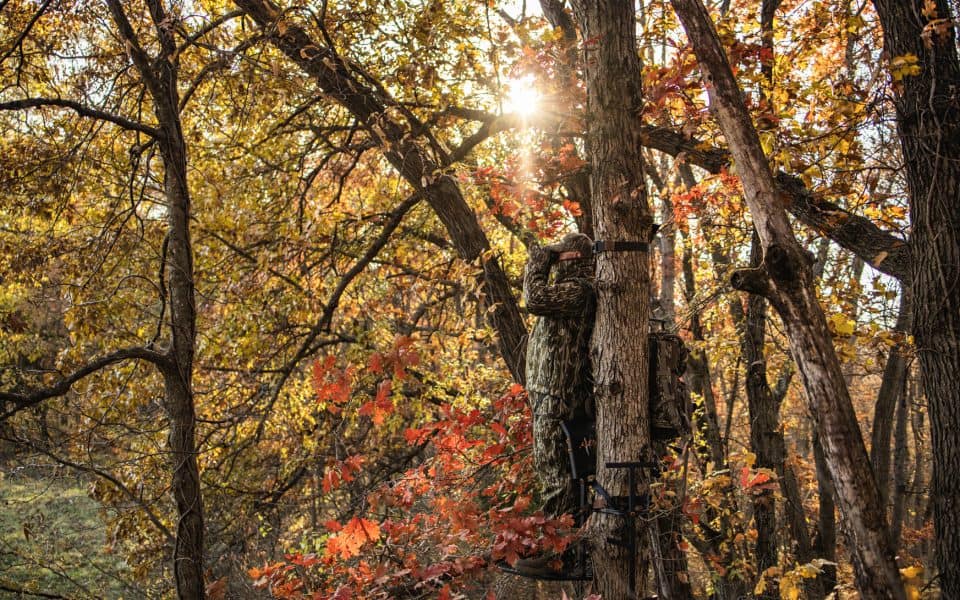Long before I was one, a veteran deer hunter once told me that your first time on a stand usually offers your best chance, and that’s especially true for opening day. It’s what trout anglers call “first water.” The area and the animals haven’t been disturbed and are still following their natural behavior patterns. Once the guns, and sometimes even the bows go off, all that changes. Success requires being in the right place at the right time. Timing has already been determined by statute. You just need to find the place. Every situation is unique but there are a few things that can guide you to find those opening day deer hunting hotspots.
Deer spend most of their time in bed; lucky them, and move about in daylight for three main reasons: to feed, to breed and to avoid danger. Hunters, on the other hand, spend most of their day sitting, waiting for the deer to move. Picking the optimal stand then involves knowing when, where and especially why the deer are moving. Those factors are inter-related, and vary with time and circumstance.
Sometimes it’s easier to hone in on hotspots by first eliminating the cold ones, and it helps if you’re familiar with the ground you hunt. My son and I share a stand that overlooks a large wet meadow. It has been our most consistent producer of deer sightings and good bucks. However, while the does live there year-round, bucks only visit during the rut, which doesn’t come in until mid-season. We’ve learned not to waste a valuable opening day on that stand.
Obviously scouting is important, and those who bowhunt can gain a distinct advantage from MRI – most recent information. But it can also be a trap. Like most of my deer hunting lessons, I learned this the hard way.
After a month of bowhunting, I had things pretty well dialed in; knew the woods like the back of my hand. I set up in the hottest spot I could find and waited for the king of the woods to stroll by when dawn broke on the first day of firearms season. That never happened. I heard plenty of shooting and saw plenty of hunters, but no deer except for fleeing flags once I got up and started moving around.
It took several seasons for the logic to kick in. Everything changed the minute that horde of hunters hit the woods, even before daylight. Instead of hunting where the deer were, I needed to be where they were heading when the guns started going off. By eliminating the negative I was able to more clearly identify the positive: the paths less traveled by other hunters.
The situation may be far different, and simpler in areas with minimal hunting pressure. You can look more for positives, and you’ll find them by focusing on the three basic elements of habitat: food, water and cover. Of course, much still depends on when your season opens.

The Lindsey Way
Deer Hunting Food Sources
Early often applies to bowhunting, but some firearms seasons start early as well. Kansas muzzleloader season opens in mid-September and South Carolina’s firearms season starts on August 15. Warm temperatures mean reduced daytime deer movement, but whitetails are easier to pattern now than at any other time of the year. Furthermore, they’re typically using a smaller portion of their annual home range. Perhaps best of all, bucks are still in bachelor groups; find one and you’ll find several.
Despite the warm temperatures, deer sense the shorter days and their internal clock signals it’s time to start fattening up. That makes any concentrated food source a good starting place. However, the whitetail’s nutritional needs, and therefore their diet, shifts throughout the fall.
In early fall body growth slows and so does the need for protein, but it is a gradual transition. Warm-season food plots like clover might still be more productive than brassicas or soybeans, the latter of which won’t reach peak nutrition and attractiveness until later. Alfalfa is another option. I’ve hunted the early season in Montana where alfalfa fields were deer magnets.

Bob Humphrey
Mast is another important food source that varies in abundance and attractiveness though the fall. In late summer and early fall, soft mast species like blackberries, raspberries, mulberries and plums are peaking. They’re among the first to ripen, and often become hubs to early-season activity. Even better, they often grow, or are planted as edge cover along the interface of forest and field, where deer will stage before venturing into the open food plots or agricultural fields.
Short of a doe in heat, few things are more attractive to deer than ripe persimmons. Even better, they often grow in isolated clumps. Like a roadside rest area, they represent a limited opportunity for deer to fuel up quickly and be on their way. I once hunted a persimmon patch in Kansas where I saw ten different bucks in one afternoon. They arrived early, and came back often.
With the first frosts, the need to feed increases. Apples are falling and a mast orchard or a grove of wild trees could be a prime spot to start the season. Food plots with cool-season annuals are starting to come into their own as plants reach peak nutrition and attractiveness. Late-drop persimmons are still falling and so is a wider variety of hard mast.
Some hard mast drops early too, especially after a wind, which is more common during hurricane season. Where I live, white oak acorns fall first, and fast, which means the period of availability won’t last long.
For all of the above, knowing when and where the mast falls is important. A bumper crop might be a boon for deer, but could be frustrating for hunters because food is everywhere. Conversely, a light crop will concentrate deer into fewer, smaller areas. It might only be one, or a few trees dropping, often the largest. This also points out why it’s important to plant or promote a variety of mast species. That way there will always be something for the deer to eat, and a potential opening day hotspot regardless of annual fluctuations in temperature and rainfall.
Speaking of rainfall, it can also influence food preferences. I’ve hunted in Iowa and Kansas, where the land managers told me the deer don’t really hit the soybeans hard until after they’ve ripened, and then been softened by fall rain.
Many states, from Massachusetts to the Midwest don’t open their regular firearms seasons until November or December. Late season generally means post-rut. Deer, especially bucks have burned up valuable fat stores and concentrated, high-calorie food sources become even more important. This is when your brassica plots really come into their own. I’ve witnessed it on my own ground. The deer will nibble through November but once the temperatures stay below freezing, the leaves, stems and stalks disappear overnight. Then the deer start pawing frozen ground for the bulbs. Winter grasses like wheat and rye are also a good option for a late opener.
Deer, turkeys, squirrels and a host of other woodland critters have been gleaning acorns for several months. As the nuts become scarcer, remnants become more important and sometimes easier to locate. Find the most recent feeding activity. Seeing sign might will be made easier by winter’s first snowfalls, and you’ll find the deer.

Linda Arndt
Deer Hunting Water Sources
Water can also represent an opening day hotspot, especially if and where it’s in short supply. That’s especially true in the warmer, early season. In drier areas, a quick scouting trip might reveal heavy trails spanning out like spokes on a wheel around a small pond or tank. Even where it’s abundant it shouldn’t be overlooked because waterways and waterbodies can funnel deer movement. A beaver dam, a narrow spot on the river or the bottom end of a lake could be an ideal intercept point.
It’s still important during mid-season where scarce, but could also factor into your late season plans as a deterrent. Where they would formerly not hesitate to wade or swim across open water, they sometimes will shy away from ice.
Utilizing Cover While Hunting
All habitat components are inter-related and I’ve already hinted at how food and cover can be combined to create preferred edge habitat with soft mast. Big food plots don’t provide much cover, but deer will use smaller staging plots earlier in the afternoon before venturing into the larger plots. This is particularly important in the early season when deer aren’t moving until the waning minutes of daylight, but also applies later on, especially as hunting pressure increases. We can refine that further by noting that deer tend to follow the shadows into a food plot, making the western side a better choice for afternoon hunts.
As alluded to above, hunting pressure can help you avoid certain areas and focus on others, like escape cover. It may look luscious but public land hunters would be well advised to avoid the low-hanging fruit. Forget the heavy trails, the open oak stands and even that red hot scrape line that other hunters have likely found as well. Look for escape routes and patches of dense cover the deer will seek out when the throng of orange-clad nimrods enters the woods.
One of my better bucks came from a heavily-hunted state management area where I located an isolated patch of heavy cover nearly a mile from the nearest access point. I slipped in well before daylight and waited for the other guys, who were hunting the “hot” sign to do the work.
This task becomes easier in agricultural areas or on the plains where narrow strips of woods, hedgerows, shelterbelts and fencerows may be the only escape cover, and a deadly deer funnel. Even in the big woods, you’ll typically find the thickest cover along stream margins. Combine that with a stream crossing and you’ve really got a hot spot.
Bedding areas can also be good spots and pening day may be the best time to push the envelope, getting as close as you dare to without disturbing the deer. It’s a bit like shooting a roost pond but if it works, the deer will have a whole year to forget about you.
Following the Deer Signs
While scouting buck sign could be a trap on heavily hunted public ground, the opposite can be true for lightly hunted areas. Over much of the northern half of the whitetail’s range, early to mid-October marks the beginning of scrape-making. It might be casual or haphazard at first, but your trail cameras will tell you which scrapes and licking branches are getting the most regular use. Just remember that visitation will be less frequent in the early season, will increase as the rut draws closer then taper off after.
As the opening passage implies, early to mid-season might be a better time to target rubs, and rub lines are better than isolated rubs, as they indicate a regular travel route. Here especially is when your first sit is often your best.
Scrapes are more of a long-shot for several reasons. One is that most scraping activity occurs at night. Another is that while they may not tend the scrape during daylight, bucks will visit it, scent-checking it from some distance downwind. In early fall when bucks are opening scrapes you might want to get tight on a traditional scrape, hoping to catch an unwary buck during one of his first visits. If your season opens around the time the first does come into estrus, set up 100 yards or so downwind.
Examples of Hot Spots
Above is a lot of generalization. To a large extent where you open the season depends on where you live and when the season starts. If I were in Oklahoma, I might be in a streamside cottonwood, just off the corner of a big green field. In Alabama, I might be overlooking the edge where a food plot abuts a dense patch of CRP or a young pine stand, or in a stand of bottomland hardwoods dropping fresh acorns. In Massachusetts, I’ll be as far away from the roads and parking areas and as far back in the woods as I can get. In Kansas, I’ll ignore the alfalfa and look for the persimmons. You have to find what seems best on the land you hunt, which is all part of the hunt.
Keep Your Options Open
Don’t put all your eggs in one basket. You may have a textbook hotspot in mind for opening day but as the opening passage illustrates, you may not be able to hunt it. Maybe the wind is wrong, or the landowner started cutting the corn too early. It’s always better to have options. You’re not going to sleep the night before anyway and deciding where to hunt will give you something to pass the anxious hours.
Conclusion
On the second day of the season, conditions were more favorable and I was able to slip into my honey hole described in the opening in hopes of intercepting the buck that made that sign-post rub. It all happened very quickly, and I had no idea how big he really was until I walked up to his lifeless body. As most know, even the best laid plans go astray, more often than not. But the season is long and a solid starting point still provides a foundation for days to come.
Join our weekly newsletter or subscribe to GameKeepers Magazine.
Your source for information, equipment, know-how, deals and discounts to help you get the most from every hard-earned moment in the field.







